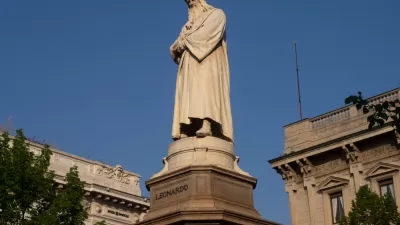The Economist looks at the looming battle between Congress and the Administration over whether to proceed now on transportation reauthorization or delay it 18 months, and concludes that the bottom line will be the funding mechanism.
Despite differences between House Committee on Transportation and Infrastructure Chair James Oberstar and DOT Secretary LaHood, there is hope that the new bill will be an improvement over the current one. Key, though, will be how to pay for it. Agreeing how to fill the broke Highway Trust Fund is central to the bill.
"Now a strategy is emerging at last. Mr. Oberstar would spend $450 billion on roads, bridges and mass transport, 38% above current levels, and devote $50 billion to high-speed rail.
Such ambitious plans, however, may have to be postponed. Mr. LaHood wants to extend the old transport bill by 18 months. Even without a new bill, there may be room for progress, says a hopeful James Corless of Transportation for America, a reform group. The transport secretary says he would send more money to metropolitan areas and use cost-benefit analyses to guide investment. The DoT is already encouraging plans to build housing near transport, expand access to buses, subways and bicycles, and reduce emissions in the process.
Still, a main question remains unanswered. The Highway Trust Fund will soon be empty. There is no consensus on how to fill it. The gas (petrol) tax, the main source of revenue for transport, has remained flat since 1993. Revenues have declined as travel has ebbed in the recession and cars have become more efficient. In the long term, congestion pricing is the best solution, but it could take years to adopt. In the meantime the Obama administration is loth to raise the gas tax. Siphoning money from general funds is an easy but unsustainable answer. There may be a new vision for transport, but it will never progress until someone is willing to pay for it."
Thanks to Bay Area Transportation News
FULL STORY: Ambitious plans for American transport run into reality

Manufactured Crisis: Losing the Nation’s Largest Source of Unsubsidized Affordable Housing
Manufactured housing communities have long been an affordable housing option for millions of people living in the U.S., but that affordability is disappearing rapidly. How did we get here?

Americans May Be Stuck — But Why?
Americans are moving a lot less than they once did, and that is a problem. While Yoni Applebaum, in his highly-publicized article Stuck, gets the reasons badly wrong, it's still important to ask: why are we moving so much less than before?

Using Old Oil and Gas Wells for Green Energy Storage
Penn State researchers have found that repurposing abandoned oil and gas wells for geothermal-assisted compressed-air energy storage can boost efficiency, reduce environmental risks, and support clean energy and job transitions.

Greening Oakland’s School Grounds
With help from community partners like the Trust for Public Land, Oakland Unified School District is turning barren, asphalt-covered schoolyards into vibrant, green spaces that support outdoor learning, play, and student well-being.

California Governor Suspends CEQA Reviews for Utilities in Fire Areas
Utility restoration efforts in areas affected by the January wildfires in Los Angeles will be exempt from environmental regulations to speed up the rebuilding of essential infrastructure.

Native American Communities Prepare to Lead on Environmental Stewardship
In the face of federal threats to public lands and conservation efforts, indigenous groups continue to model nature-centered conservation efforts.
Urban Design for Planners 1: Software Tools
This six-course series explores essential urban design concepts using open source software and equips planners with the tools they need to participate fully in the urban design process.
Planning for Universal Design
Learn the tools for implementing Universal Design in planning regulations.
Heyer Gruel & Associates PA
City of Moreno Valley
Institute for Housing and Urban Development Studies (IHS)
City of Grandview
Harvard GSD Executive Education
Salt Lake City
NYU Wagner Graduate School of Public Service
City of Cambridge, Maryland





























